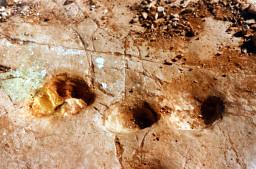Ancient fossilized footprints left by the predecessors of dinosaurs have been discovered in northern Italy, scientists said on Thursday.
The footprints, the oldest ever discovered in Italy, date back to the Triassic period, around 220 million years ago.
Palaeontologists discovered around 70 footprints in a rock wall near Zone, a town east of Lake Iseo near Brescia.
The footprints were all between 12 and 40 centimetres in diameter, which scientists initially thought indicated the reptiles were fairly small, somewhere between the size of a dog and a horse.
But further research led them to conclude this was not the case, and the carnivorous reptiles were actually around six metres long.
They calculated the size of the animals by measuring the distance between the different footprints, which allowed them to work out the length of the reptile's stride, as well as the distance between fore and hind legs.
They believe that only part of the creature's foot came into contact with the ground when it walked, accounting for the comparatively small size of the footprint.
The footprints have also led palaeontologists to conclude that these dinosaur precursors had an unusually sophisticated style of walking compared to their closest surviving descendants, crocodiles.
The fossilized remains include no indication of tail drag, suggesting the animals had long, vertical legs under their body that kept tail and belly far from the ground, similar to some species of dinosaur.
According to the team, these are not just the oldest but also the largest fossilized remains of their kind found in Italy.
The dinosaur predecessors - as well as many other creatures such as mammals, lizards, crocodiles, turtles and frogs - existed alongside dinosaurs between 235 and 200 million years ago.
But around 200 to 120 million years ago dinosaurs dominated the planet and their predecessors vanished
The team will reveal more details of their discoveries, following an extensive laser study, on April 16 at the Natural History Museum in Milan.




